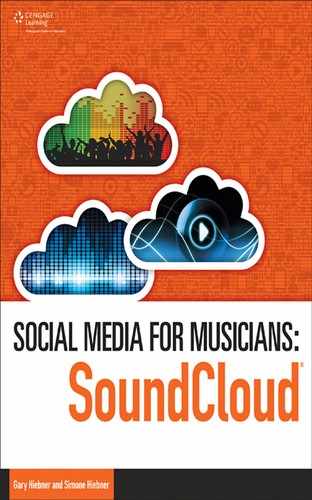13
Advanced SoundCloud
WE’VE LOOKED AT CREATING AN ACCOUNT, populating it with your tracks, creating playlists, and in general having a SoundCloud presence. In this chapter, we’ll take a deeper look at some of the elements we’ve touched on to help you get even more out of SoundCloud.
Back to the Profile
Let’s begin by taking a closer look at your profile. Click on your profile picture and then, in the drop-down menu, click on Profile. On the left side of the screen, below your profile picture, click on the Edit button, as shown in Figure 13.1.
Figure 13.1 Your profile—editing the details.
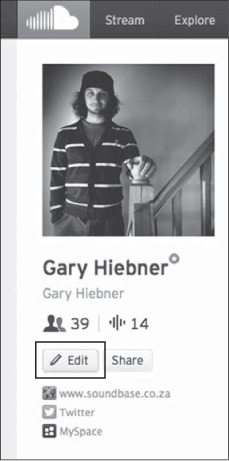
Source: SoundCloud®.
Here you can change your username and profile link if you’d like to. You can also upload a new profile picture via this screen, but note that when you change your image here, the Instagram option is not available; you’ll only be able to navigate to a set place on your hard drive.
On this screen you’ll also notice some other fields that you can fill in, including your real name, location, and occupation. Remember to click Save for any changes you’ve made on this page.
Your Advanced Profile
The next area we want to look at is the Advanced Profile option, still under the Edit section of your profile (see Figures 13.2 and 13.3).
Figure 13.2 Navigating to your advanced profile.

Source: SoundCloud®.
Figure 13.3 Your advanced profile—getting social.
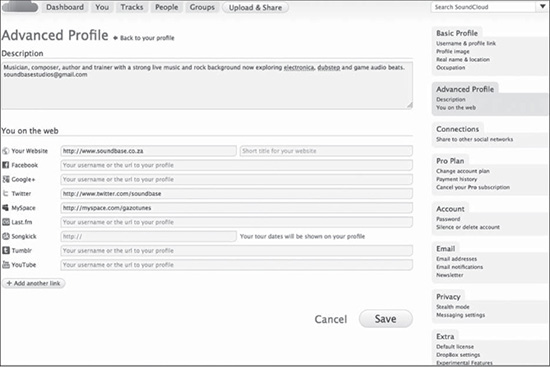
Source: SoundCloud®.
This a great area to make use of your social media channels. Why does that matter? When someone finds you on SoundCloud—either by actively searching for you or by exploring the vast database of music available—you want to be able to extend your web presence to them. If they want to know how to find you on Twitter, for example, you want that information available—and all the other numerous channels you and your brand exist on.
Having a great description is also valuable on SoundCloud—and we’re sure by this time you can understand why. This is your platform to let people know more about you as an artist, group, or brand. Go for a quirky or informative bio. Why waste the opportunity to say a little something about you, your music, and your brand? If you have any notable mentions, add these in. Also, remember to include some way for people to contact you—either your email address or that of a representative. You’ve done all this work; let it translate into opportunities for connecting with people outside of SoundCloud, too.
For your social media channels and website, fill in as many as you can so that your fans can follow your journey on a number of different platforms. Remember, although they have found you on SoundCloud, they may want to follow your story on their Facebook or Twitter feed. If you have a YouTube channel, you’ll definitely want to list it to give people the chance to see the visual element of your brand. It seems simple enough, but there’s value in meeting people where they are and giving them the option of following you on their social platform of choice—even if that is supplemented by others.
Each platform has its own benefits to users. The limited number of characters available on Twitter results in concise messages and links to other elements; Facebook allows you to share content, connect, and share visual elements; and YouTube is your brand represented in motion with your music video, a behind-the-scenes session, your band on tour, and other engaging video content to give your fans something extra. (For more on YouTube, read Social Media for Musicians: YouTube.) Listing all of your social media elements on your SoundCloud profile makes you accessible on all those levels and adds to your marketing clout.
Connections
Connections is the heading below the Advanced Profile section of your profile settings. The Connections page allows you to quickly and easily share your new tracks with your Facebook, Twitter, Tumblr, and Google+ audiences by connecting these accounts to your SoundCloud profile for automatic publishing to these channels (see Figure 13.4). You can edit your default notes that relate to sharing your tracks and new favorites that you’ve discovered on SoundCloud. This area of your profile will also show which of the applications you have allowed access to, and you can revoke this access by clicking on the Revoke Access button next to the relevant account. Connections is another way SoundCloud helps you reach a wider audience than just the one within the SoundCloud arena.
Figure 13.4 The Connections page.
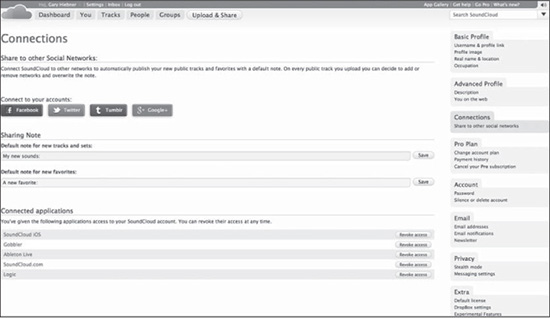
Source: SoundCloud®.
Activity Notifications
Other than the page that houses your email address, the email settings page also contains the activity notifications (see Figure 13.5).
Figure 13.5 Navigating to email notifications.
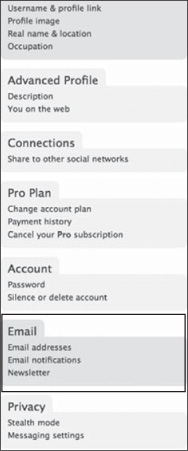
Source: SoundCloud®.
These can be useful to you in tracking your SoundCloud activities, and you can enable or disable those activities that you want to receive information about. You may want to have them all selected, or perhaps a mixture. Remember, if you’ve started a group, you’ll want to keep Pending Group Contributions checked so that you can keep an eye on the tracks that require your attention for moderation.
SoundCloud Pro
SoundCloud Pro allows you two paid options for getting even more out of your SoundCloud account through a number of added benefits (see Figure 13.6). The two paid options are Pro (about $4.17 or 3 Euros/month) and Pro Unlimited (about $12.50 or 9 Euros/month). Let’s take a look at how they differ from a standard account:
Figure 13.6 Comparing SoundCloud accounts.
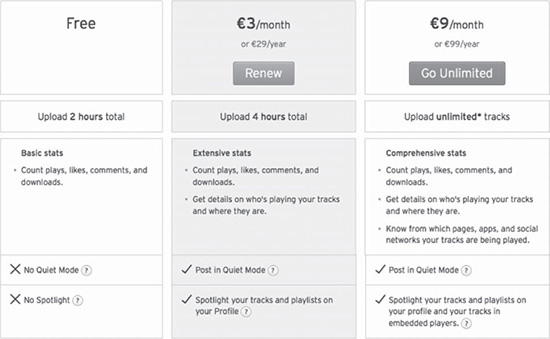
Source: SoundCloud®.
With a standard account, you can upload 120 minutes’ (2 hours’) worth of tracks to SoundCloud. If you find that you want to add even more tracks to your profile, Pro allows you double that amount, at four hours, and Unlimited lives up to its name by allowing you to post an unlimited number of tracks—as long as they abide by the 2-GB file size limit and your weekly upload time limit is within 30 hours.
Standard accounts give you access to what SoundCloud calls the “basic stats.” You can count plays, likes, comments, and downloads. With Pro, there’s an added level of detail—you can see who on SoundCloud is playing your track and where they are geographically. This information can be valuable in tracking your influence—if you have planned an upcoming gig, how many fans from that area are listening to you? Or before you even book your next live performance, you can determine in which area you have the biggest audience. Or, if you found that a large number of your SoundCloud audience was in France, you might add a French line to a remix of one of your songs and see how it measures with your audience. You can take the information and use it in a number of interesting and experimental ways. Make use of knowing which tracks are working and which fans are reacting to them. And if these fans are fellow musicians, go over to their profiles and interact, comment, and like—remember the importance of community building.
The Unlimited plan takes this even further. You can see statistics on who and where (including an option to look at the top cities where your hits are coming from), but you can also gain insights into where online your tracks are being played. This means that you can see which pages/blogs/websites, applications, and social media sites are displaying your content and where it is most popular. You can use this information to focus your attention on a particular channel and meet your fans where they are. For example, if blogs are giving you a high level on engagement, look for opportunities to work with those sites to build your brand. Perhaps you could submit a remix of a song that has performed well with their audience or consider writing a piece about your musical process and submit it to them. If you find that Facebook is a favorite among your fans, concentrate some added attention on that platform to enhance your engagement levels there.
Quiet mode is a feature of both the Pro and Unlimited accounts. This allows you control over comments and statistics related to your track; you can have them either visible or hidden. To enable Quiet mode, go to a track’s page, which you can find via your profile icon, and then click on Tracks. Next to a track, click on the Pencil/Edit icon. Navigate to the bottom of the track’s page to see the Quiet mode options (see Figure 13.7).

Source: SoundCloud®.
Spotlight is another feature that falls only under the paid SoundCloud options—and differs between Pro and Unlimited (see Figure 13.8). With Spotlight you can put the best representation of yourself at the top of your profile, and this applies to both your tracks and playlists. After these songs are selected as your spotlight songs, the usual order of the last uploaded track appearing at the top kicks in for the display of your other tracks and playlists. Simply click on Edit Spotlight on your profile page and then click on the search bar to choose which songs you want to have in your spotlight. You can have up to five tracks appearing here.
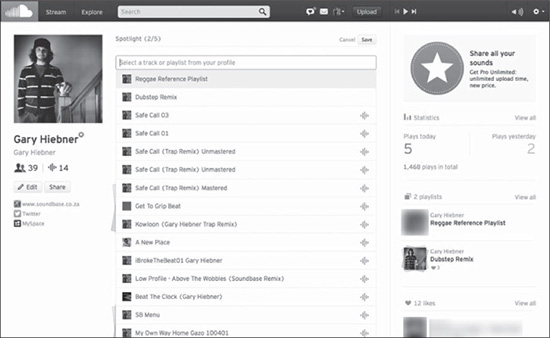
Source: SoundCloud®.
What’s different with Unlimited? Once your track has ended in an embedded player, the Unlimited plan allows you the added extra of having one of your spotlight songs show up as a recommended track.
SoundCloud has a 30-day money-back guarantee on their Pro plan, so if you aren’t ready to commit right off the bat, know that if you cancel within 30 days, your money will be refunded.
Sharing from SoundCloud
We’ve mentioned how you can use the Share function in SoundCloud—whether it be with a track or a playlist—to extend your reach from SoundCloud to another application or platform, such as Facebook, Twitter, Tumblr, Google+, or Pinterest, or to email via your native email application (if you have one set up). You can also embed this information or mail it directly from SoundCloud.
Tracks aren’t the only things you can share via SoundCloud. Explore the options of sharing your profile, too, or that of a musician you are following and inspired by. It’s another way of getting your name out there—either as an artist or as an artist promoting a fellow musician. Again, remember the value of networking and involving yourself in the SoundCloud community.
Let’s take a closer look at these options. There are ways to integrate the SoundCloud player into other social media sites, such as Facebook, and even into other websites, such as your band’s webpage or even your own personal blog. It might get a bit techie here, because we’ll be talking a bit about HTML code, but don’t worry—it’s really easy if you just follow the steps.
SoundCloud makes this all really simple with the necessary code already generated for you. As we’ve mentioned, this is all done through the Sharing option on your SoundCloud track. So choose which track you want to use and then click the Share button (see Figure 13.9).

Source: SoundCloud®.
Choose which option you want, and this will bring up the dialog box linking to that social media channel. Let’s use Facebook for our example—this is represented by the Facebook icon, as shown in Figure 13.9.
Click on the Facebook icon and then click on Share at the bottom of the Facebook pop-up window, as shown in Figure 13.10. Then navigate to your Facebook page to see how the SoundCloud player has been added to your comment (see Figure 13.11). This is a neat way to integrate SoundCloud with your Facebook interactions. Maybe you want to let your fans know of a new track you’ve written. Instead of trying to get them to navigate to your SoundCloud page, just share your SoundCloud track with your Facebook profile, and listeners can hear the track right from your timeline.
Figure 13.10 Sharing a SoundCloud track with Facebook.
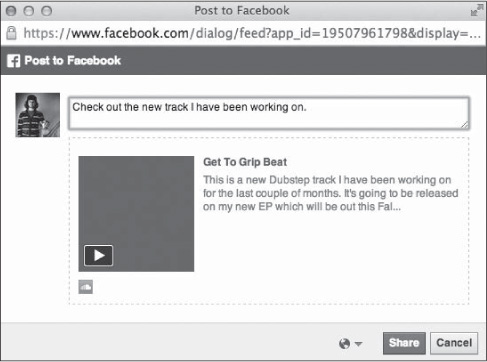
Source: SoundCloud®.
Figure 13.11 The SoundCloud player embedded in a Facebook post.
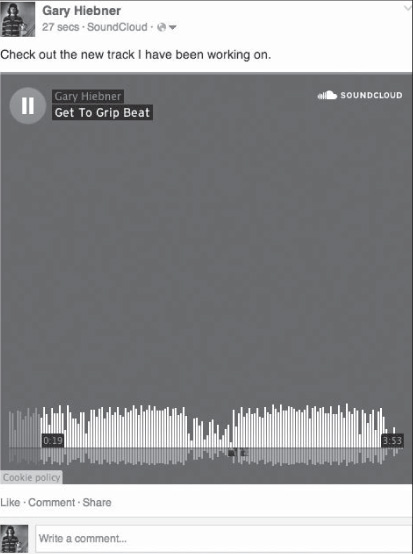
Source: Facebook.
What if you want to add a song to your website? You’ll need to use the Embed option. Click on Embed, and SoundCloud will show you the code you need to embed in your website to show the SoundCloud web player for the song, as you can see in Figure 13.12.
Let’s use a blog as an example. I’ll use my Blogger page. You’ll need to know how to view the HTML code for your website/blog. If this is a bit high end, maybe you can get some advice from a web developer. Perhaps you have a friend who can help you or you can speak to whoever maintains your website for advice about how to add this. (Maybe they have a backend facility that you can access to add the HTML code for the SoundCloud player.)
When you’re in the HMTL editor (see Figure 13.13), you can paste the HTML code provided by the SoundCloud Embed sharing option. Save the changes and then, when you navigate to your website/blog, you’ll see the SoundCloud web player for that track embedded in the page. We’ve included an example here in Figure 13.14.
Figure 13.12 Getting the HTML code to paste in a website.
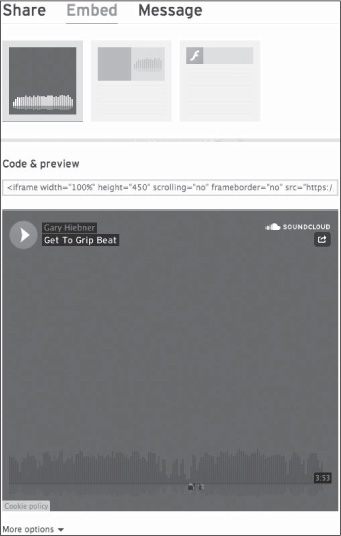
Source: SoundCloud®.
Figure 13.13 Pasting the HTML code into an HTML editor for the website or blog.
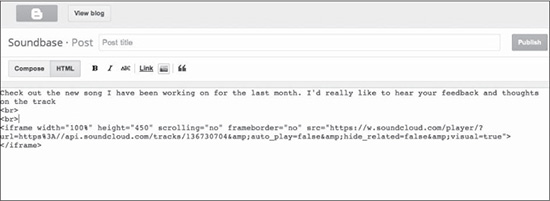
Source: SoundCloud®.
Figure 13.14 The SoundCloud player embedded in a blog.
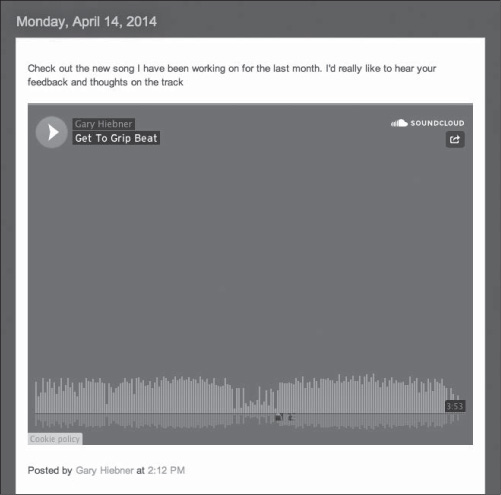
Source: SoundCloud®.
It’s evident from this chapter that the team at SoundCloud has put a lot of thought into giving musicians, composers, and artists a number of channels through which to share content and connect via a multitude of platforms. Throw in the Pro plans, and as a content creator, you can tailor your marketing ideas to suit your platforms according to where your fans are and how they’re engaging with you, with the option to showcase yourself in the spotlight. Start experimenting and see what works for you, and develop your ideal SoundCloud workflow by making use of the statistics and sharing tools to get the most out of SoundCloud.
